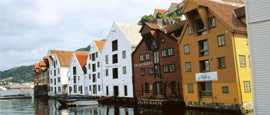Located in several buildings along the Lille Lungegårdsvann lake in the city centre, this Bergen institution is a must-see for any art lover. If you're short of time, focus on the fascinating Rasmus Meyer collection, where some of the best Edvard Munch paintings outside Oslo are on display, as well as major works by other significant Norwegian painters. The Stenersen Collection next door focuses on modern art, again with big names on display, including Max Ernst, Vassily Kandinsky, Paul Klee, Joan Miro and Pablo Picasso.
Things to see in Bergen
Tourist offices
Address: Strandkaien 3 , Bergen, Norway
Tel: 5555 2000.
Opening Hours:Daily 0830-2200 (June-Aug); daily 0900-2000 (May and Sept); daily 0900-1600 (Oct-Apr).
www.visitbergen.com/
During summer, there is an additional information office by the harbour at Skoltegrunnskaien and another all year at Flesland Airport.
The Bergen Card allows free bus travel within the city limits, discounted parking and free or discounted admittance to many of Bergen's museums and attractions, sightseeing tours and entertainment venues. A 24- or 48-hour Bergen Card can be purchased at the tourist information office, the railway station, the Express Boat Terminal, youth hostels and many hotels and camping sites.
Considered by UNESCO to be one of the world's foremost showcases of the Middle Ages, Bryggen consists of a series of gabled buildings situated on the old wharf of Bergen. It stands as a reminder of Bergen's prominent role in the days of the Hanseatic League, an organisation founded by a group of northern German towns to protect their mutual trading interests in the 13th to 15th centuries. The buildings were mainly used as warehouses for the dried fish trade, but also contained offices and simple living quarters for merchants, journeymen and apprentices.
Today, Bryggen is alive with restaurants, cafés and artists' workshops, and a colourful attraction at the eastern end is Torget, a weekday market selling fruit and vegetables, handicrafts and souvenirs. and Saturday 0700-1500. Slightly reduced hours operate outside the peak season.
After the destruction of several Hanseatic houses in 1955, archaeologists excavated the area and unearthed the remains of the oldest settlement ever discovered in Bergen (dating from the 12th century). This museum was built around the remains, and displays various artefacts, including traditional costumes. Collections include runic inscriptions, ceramics and other items illustrating commerce, shipping, cultural activities, handicrafts and everyday medieval life. Temporary exhibitions are also staged here.
The Hanseatic Museum is housed in one of the oldest wooden buildings in Bryggen. It was razed to the ground in 1702 but subsequently rebuilt and features two trading houses - one sea-facing and the other in the back of the tenement. Furnished in 18th-century style and the only one to have retained its original interiors, it provides an insight in to life at that time as lived by wealthy Hanseatic merchants. For 400 years, they traded fish and grain.
On the tip of the peninsula, the Bergen Aquarium contains one of the finest and most extensive collections of marine fauna in Europe. Seventy tanks and three outdoor pools are complemented by an extension containing a realistic nesting cliff, open-plan tanks, an exhibition and video facilities. There are also sections covering marine industry and polar sea life, and an exhibition featuring amphibians and aquatic reptiles. The feeding of the penguins and seals is always popular with visitors.
Fløibanen has been carrying people 320m (1,050ft) up the Fløyfjell Mountain for more than 80 years - a one-way trip takes about eight minutes. The views over the city and offshore islands from the summit are spectacular. There is a restaurant (summer only) and shops at the top, as well as mountain walkways.
Situated about 7 minutes' bus ride from the city centre, this open-air museum features a collection of around 50 houses depicting life in Bergen as it was in the late 18th, 19th and early 20th centuries. In this reconstructed town, visitors get a glimpse of private homes, shops and workshops. Old Bergen is an idyllic reminder of what Bergen used to be like.
Built in the 1560s by Erik Rosenkrantz, governor of Bergenhus, Bergen Castle once served as a fortified residence. It incorporates earlier structures including a 13th-century keep and is adjacent to the equally significant Håkon's Hall, named for King Håkon Håkonsson, who ruled Norway from Bergen in the mid 1200s. The tower itself is considered to be one of the most important renaissance monuments in the country. Visitors can climb narrow, dark stairs for impressive views at the top.
Bergen Maritime Museum offers a history of shipping, its development and importance to Bergen and Norway in the past and today. Exhibitions include ship models - including viking ships - paintings, marine archeological findings and various items related to seamanship and life on board.
This lovely 1770s manor house is in Laksevåg, 3km (2 miles) west of Bergen city centre and is considered Europe's best-preserved wooden building from this period. The gardens of 200 years ago have been recreated - both in terms of the plants and the overall design. It is an example of the lavish countryside retreats favoured by the aristocracy during the 18th century when Bergen prospered. Its castle-like facade is an important example of rococo architecture in Norway.
This is Bergen's oldest building (dating from the first half of the 12th century) and one of the country's best examples of Romanesque architecture. The pulpit is generally regarded as the finest example of baroque decorative art in Norway. Concerts are regularly performed here in the summer months.
Do you have any Feedback about this page?
© 2025 Columbus Travel Media Ltd. All rights reserved. No part of this site may be reproduced without our written permission, click here for information on Columbus Content Solutions.








 You know where
You know where